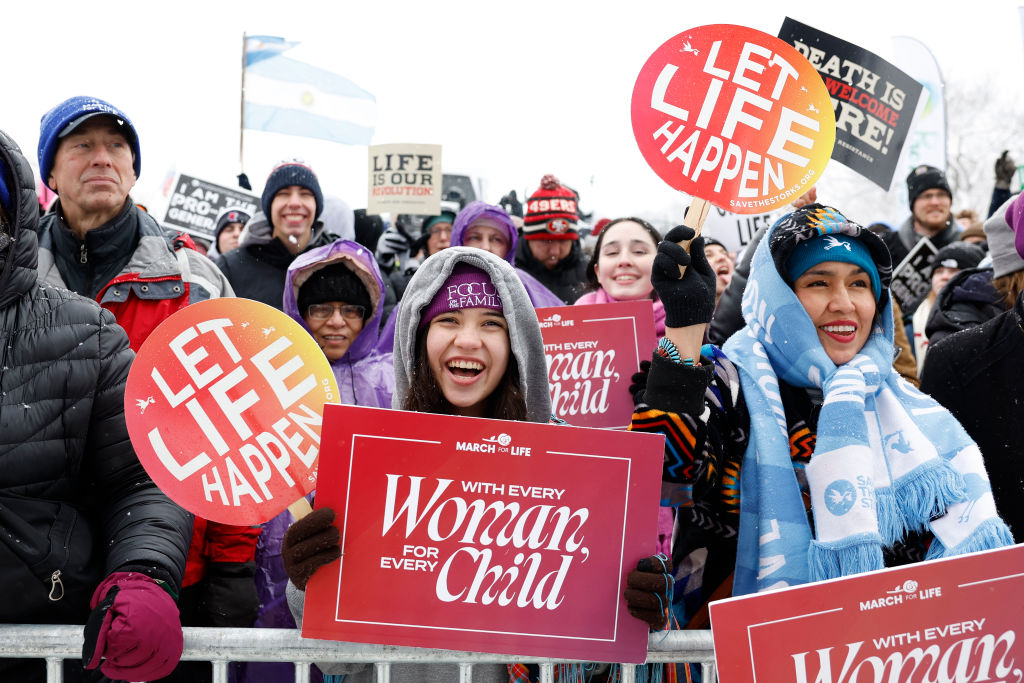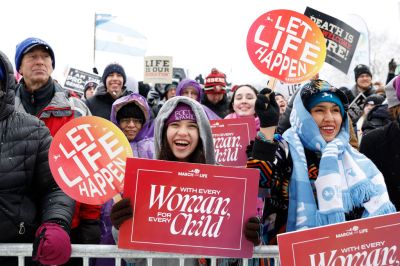In the fall of 1973, horrified by the Supreme Court’s Roe v. Wade decision earlier that year, a lawyer in the Labor Department organized a meeting of a small group of women in her home. Nellie Gray, a Texan and veteran of the Women’s Army Corps during World War II, worried that the anniversary of the monumental decision would pass by without being remembered. And she had reason to think so. Many considered this the end of the conversation over abortion.
While the Catholic Church was vocally opposed to the practice of abortion, evangelical Christians had a mixed response. Christianity Today condemned the ruling as “counter not merely to the moral teachings of Christianity through the ages but also to the moral sense of the American people” while the largest Protestant denomination, the Southern Baptist convention, was initially ambivalent. A poll taken a few years before Roe found 70 percent of Baptists supported the right to abortion. Few pundits and prognosticators thought this would be a contested issue in American life.
Yet what Gray and others catalyzed in those early days grew: 20,000 people showed up in January 1974 to march past the Capitol and on to the Supreme Court in what would become an annual rite for those who care about the sanctity of life. Evangelical philosopher Francis Schaeffer toured the country with Boston pediatric surgeon C. Everett Koop, giving lectures on the moral horror of abortion and touting their video and book, Whatever Happened to the Human Race? Pro-life ethicist Richard Land became the Southern Baptist Convention’s chief public policy spokesperson. Ronald Reagan, who had signed legislation loosening abortion laws in 1967 as governor of California, ran for president in 1980 promising to oppose the practice. Shortly after he wrote a small book, Abortion and the Conscience of the Nation, outlining his beliefs.
As the march grew into a movement, there were small yet significant victories along the way. The 1976 Hyde Amendment prevented the federal funding of abortion. The 1984 Mexico City Policy kept foreign aid going to abortion, though the policy has typically been enacted by Republican presidents and rescinded by Democratic presidents.
Yet the biggest goal, overturning Roe, always seemed more aspirational than probable. Year after year pro-lifers worked to elect presidents to nominate and senators to approve Supreme Court justices who might be willing to strike down the case. Yet after many near-misses—such as 1992’s Casey v. Planned Parenthood decision—it all still seemed impossible. Come 2022, many pro-life groups were meeting in anticipation of a half-century anniversary.
Then the unthinkable happened: The Supreme Court reversed itself in the Dobbs decision in June 2022.
What began in a living room in Washington in 1973 became one of the most effective social and political coalitions in American history, provoking—through a mosaic of legislative, legal, cultural, scientific efforts—the nation’s conscience with a new moral vocabulary.
So now what?
The movement has some advantages now it did not have five decades ago: durable institutions, political leaders who champion the cause, and a public that favors modest restrictions on abortion. Yet today, as in 1973, enormous challenges confront those who care for the unborn.
Ironically, the end of Roe—which once seemed impossible—complicates the legal and political fight. The pre-Dobbs legal argument was fairly straightforward. Even the late Justice Ruth Bader Ginsburg, a champion of abortion, admitted that Roe was a flawed legal ruling.
Now the arguments are more nuanced. Is abortion a state issue? A federal issue? Look no further than the Republican presidential primary contest for proof: Former President Donald Trump has criticized Florida Gov. Ron Desantis for signing a six-week abortion ban. Some candidates have insisted that the arguments against Roe—that abortion should be decided by voters in the states—should be the ongoing standard, while others argue the federal government has a role to play in regulating abortion.
Dobbs was also a galvanizing event for the pro-choice community, which was eager to seize on this moment. Abortion supporters captured the zeal of their young base. They also won ballot victory after victory across even red states like Kentucky and Ohio.
Stung by setbacks, some pro-lifers may despair. But we should not—despite the wishes of so many—go away. Instead we need the aspirational hope and long-term vision of those first courageous advocates. We still need to see ourselves as a movement. Every effective force for justice has taken the long view, even if that horizon stretched past their lifetimes. Abolitionist William Wilberforce’s fight to end the slave trade in Great Britain took him his entire life. The civil rights movement has been a long, slow, painful march. And ours will be as well, replete with setbacks and losses.
Pro-choice advocates and many sympathetic media voices are quick to say that the pro-life movement was caught flat-footed for the day Roe fell. But that thesis is too simplistic. For years, pro-life advocates preached that the legal battle was just the beginning of the fight, which would then proceed state to state and would require much more changing of hearts and minds.
Still, a new era will require new approaches. The legal fight, so persistent and effective, will take a myriad of forms, from working to stop the distribution of abortion drugs at the federal level to conscience protections for people of faith. We know legal restrictions on abortion work, as evidenced by the reduction abortions in the months following the Dobbs decision.
The legislative approach will take many forms, too. Perhaps states with pro-life majorities will pass comprehensive restrictions while swing states adopt incremental ones. Legislators should be wise to carefully word their legislative language to include the rare exception for cases in which the mother’s life is in danger and then effectively communicate those clarifications in the face of widespread misinformation and hyperbolic coverage. Pro-life public officials should talk about these hard cases with compassion and care. The Kate Cox case in Texas was an example both to correct the common misconceptions about the health of a mother and also demonstrate genuine compassion toward her. And pro-lifers should be steadfast, but realistic, at what can be accomplished at the federal level. Without a 60-seat pro-life majority in the Senate, even incremental restrictions will mostly stall in Congress.
Yet the most important, long-term project is cultural. Though the pro-life message is a half-century old, we falsely assume every generation has heard it. New cohorts of young people may be awakened to the horror of abortion for the very first time and might be persuaded by the growing body of science that demonstrates life at the earliest stages of development. Pro-lifers should not give up the art of persuasion, adjusting and adapting the apologetic for a new age.
Those conversations may happen in places we hadn’t anticipated before Dobbs. Recent ballot defeats in conservative states like Ohio and Kentucky demonstrate that large cohorts of Republican voters, when asked as a single issue in a referendum, are less sympathetic to the pro-life cause. Shifting political maps have seen Trump bring in many working class, previously Democratic voters, to the Republican Party. Many aren’t part of church communities and are right-leaning when it comes to immigration and other issues, but are ambivalent about or even supportive of abortion. As Francis Schaeffer and others made the case in the 20th century, so too must a new generation make the case today with innovative approaches and persuasive arguments.
Pro-lifers have always understood that abortion is downstream from other cultural issues, particularly the economic and social struggles of American families. Many women today are alone, abandoned by men who see abortion as a way of escaping responsible fatherhood. Thankfully, a network of thousands of pregnancy resource centers connect mothers with resources and communities, usually religious ones, that can help buoy motherhood in those early years. But we need to supplement this good work with a renewed emphasis on the goodness of the family. Sociologist Brad Wilcox and others have documented the social benefits of stable, two-parent families even as the share of single-parent homes continues to rise in the US. Conservatives should not hesitate to champion the family and find ways to stabilize homes economically. Many pro-life leaders are already thinking in these holistic ways.
Conservatives should also recover a political philosophy of virtue, not in an self-righteous, preening sort of way, but in keeping with the spirit of the American founding. The Constitution was made for a “virtuous and moral people,” John Adams famously wrote. Many who champion faith do not, as so many progressives often argue, seek to construct a theocratic state. Rather, they acknowledge that freedom can become atomized anarchy without Judeo-Christian religious morality. Christianity emphasizes liberty to serve God and others in the context of community, as opposed to libertinism and unbounded individualism. Yuval Levin accurately diagnoses this malady in his book, The Fractured Republic:
The capacity of individuals to define the terms of their own existence by defining their personal identities is increasingly equated with liberty and with the meaning of some of our basic rights, and it is given pride of place in our self-understanding.
The American Founders understood this idea well. In his letter to the Massachusetts Militia, Adams wrote:
Morality and virtue are the foundation of our republic and necessary for a society to be free. Virtue is an inner commitment and voluntary outward obedience to principles of truth and moral law. Private virtue is the character to govern oneself according to moral law at all times. Public virtue is the character to voluntarily sacrifice or subjugate personal wants for the greater good of other individuals or the community.
Where it has influence, the pro-life movement should attempt to frame its arguments in the context of virtue. This might involve a distancing from amoral, barstool conservatism. Sometimes we may be forced into political alliances with imperfect characters. But we should not turn votes into endorsements of the worst behavior. While we welcome advocates where we can, we should be careful about platforming, as champions, those who champion a sexual ethic that feeds the abortion industry. Thankfully, many across the ideological spectrum are starting to question the aims of the sexual revolution and reconsider the virtues of stable, nuclear family life.
As I write this, I’m leaving Washington, D.C, and reflecting on another trip to the nation’s capital to join the protest Nellie Gray started a half century ago. The first march began four years before I was born. Yet I will fly home to continue teaching my own children, now teens, about the importance of standing up for the dignity of every human life. And I wonder, as they grow into adulthood, what stories will they tell. What movement will they inherit? What aspirational pro-life milestones will they see achieved in their time? We can, and must, hope and pray and act.






Please note that we at The Dispatch hold ourselves, our work, and our commenters to a higher standard than other places on the internet. We welcome comments that foster genuine debate or discussion—including comments critical of us or our work—but responses that include ad hominem attacks on fellow Dispatch members or are intended to stoke fear and anger may be moderated.
With your membership, you only have the ability to comment on The Morning Dispatch articles. Consider upgrading to join the conversation everywhere.